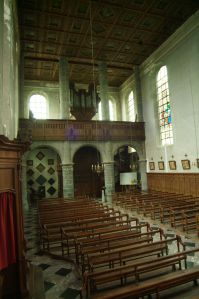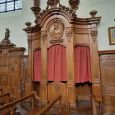Abbey Sanctuary | 1623 | Classical | Catholic Church


Map
Opening hours
01 January - 31 December
Mon 9.00 - 18.00
Tue 9.00 - 18.00
Wed 9.00 - 18.00
Thu 9.00 - 18.00
Fri 9.00 - 18.00
Sat 9.00 - 18.00
Sun 9.00 - 18.00
Guided tour
On request :
fnd2009@skynet.be
or +32 82 22 28 70 (Maison du Tourisme de Dinant)
Religious offices
Sunday 10 am
Description
Located in a beautiful unspoilt environment on the heights close to Dinant, encircled by a few stone houses, this church owes its founding to the discovery of a statuette of the Virgin Mary in a hollow tree by a woodcutter in 1609. The statue was worshipped. As a result of miracles the place became a pilgrimage site and this church was built in 1623.
At this time the development of the cult of the Virgin was part of the Counter Reformation on the initiative of the Jesuits, who encouraged the cult of saints by images in reaction to the austere religion of the Protestants, who communed with God without intermediaries.
The most noteworthy feature of the building is its famous ceiling made of 145 panels of oil paintings depicting scenes from the life of Mary and portraits of saints. This ceiling is the work of the brothers Stilmant of Dinant and the painter Guillaume Goblet. It was restored in 1935 but now needs another refurbishment. Inside, apart from the celebrated ceiling, is the miraculous statuette on the left of the altar and various paintings including ones of the Virgin and Saint Joseph.
The immediate surroundings of the church are charming with a little graveyard next to it, a small wall encircling the church, a bench for visitors, an inn, a chestnut tree, a fine view.
KIKIRPA : Photo-library online
400th anniversary of Foy Notre-Dame: programme of festivities
Photos
Media
Remarkable elements
The statuette and the origin of the sanctuary
In the summer of 1609, a woodcutter cuts down an oak in the forest of Foy, owned by the lord of Vêves. In the trunk of the tree he finds the statue of the Virgin, split into two by the power of chopping. A little girl takes the two pieces with her and glues the figure with a few licks of wax. The lord of the castle then places the statue in his castle. Miracles are established, to the extent that the believers flood in in large numbers. Surprised by the coming and going of these people, the lord of the castle decides to bring the statue back to the place where it was found and to build a small oratory there. The cult grew to such an extent that a large church was built in 1622.
Translated with www.DeepL.com/Translator
Cult dissemination
The origin of the success of this story: the epilogue of a Jesuit from Dinant in connection with the discovery of the statue. The Society of Jesus distributed it throughout the world, with a piece of wood from the tree in which the statue of the Virgin was hidden. Since then, there have been numerous small statues carved from these pieces all over the world and in the big cities that bear its name, such as Santa Fe in Uruguay and the city of Sainte-Foy in Quebec.
Confessional
According to tradition, the present confessionals come from the old Jesuit church in Dinant. It had to be dismantled and its contents distributed after the abolition of the Society in 1773. It is a masterpiece of Namur's joinery, characterised by a strong moulding pattern, a very structured cornice and fine decorative motifs applied and not made from the masses. They carry in a medallion the images of the two saints of the Society of Jesus: on the left Saint Ignatius and on the right Saint Francis-Xavier.
Rosary
The main theme of the decoration of the church. It is present three times: on the ceiling, which consists of a central axis, on the side altar on the left and, partially, on the windows of the choir. The secrets form the central axis on the ceiling with, as apothéose, the coronation of the Virgin, painted on a slightly larger panel. The composition of these panels brings the believer step by step to the heart of the sanctuary, to the glory of the Virgin.
On the side altar on the left is a panel representing the granting of the Rosary to the Holy Dominic, as the legend tells us (15 medallions for the 15 secrets). And choir windows represent the sad secrets.
Caisson ceiling
The cassette ceiling is designed to form a cross. The paintings represent scenes from the life of the Virgin Mary but also portraits of the evangelists and the four fathers of the church. And all around the cross are portraits of saints. Some ceiling panels (a total of 145) were donated by passing pilgrims.
The worship of the shepherds
This object is a work typical of the Counter Reformation, which is at the origin of the history of the statue and its sanctuary. It was painted by a great Liège master, François Walschartz, on order of Prince Bishop Ferdinand de Bavière. The arrangement differs from that of the Flemish Primitives: here Mary is not in admiration for her divine son, but introduces herself to the shepherds. Carrying him on her lap, she associated herself with her son in the face of the visitors. Mother and child are thus the heroes of the scene, who present themselves in the sight of the shepherds, while Saint Joseph mixes with all the admirers.
Sainte Marie / Dames de choeur - campagne 2021
La monumentale église de Foy-Notre-Dame doit sa construction à la découverte en 1609 par un bûcheron d’une statuette de la Vierge Marie au creux d’un arbre. La statue fut vénérée. Suite à des miracles, l’endroit donna lieu à des pèlerinages.
Partners
Nearby
Circuit
Pilgrimages and legends

Detours and other pilgrimages in Namur (loop 5) - This tour takes you in the footsteps of two pilgrimages that were very important at the time: one goes back to the Middle Ages and the other to the 17th century. What do they have in common? The coming of the great ones of this world to pray and meditate.




























